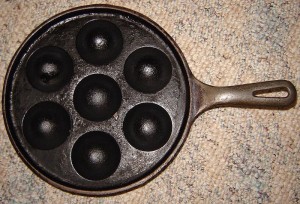by Cat, Nov 2012 (Photo, right, from Wikimedia Commons)
Æbelskiver were a favorite treat that my Mom made, not only for our family, but also for a few good customers in our bar (like Long George Wells, who called them ‘apple skivvies’), and for her special friends. She referred to them as hotcake balls, for those who didn’t understand the Danish name.
In Denmark, æbleskiver are often served in the days leading up to Christmas, accompanied by Julegløgg (Danish Christmas Mulled Wine). The other half of my ancestral heritage – Norwegian – serve waffles with strawberries and whipped cream, and lots of black coffee, for similar occasions.
Even tho the æbel part of the name means ‘apple,’ æbleskiver do not contain apple (tho some Americans believe they should include apple or applesauce). They are so named because their round shape resembles an apple.
See also: 1. Ethnic – Scandinavian Foods; 2. Julegløgg (Danish Christmas Mulled Wine)
Æbelskiver (Danish Pancake Balls)
This recipe is from Wonderful, Wonderful Danish Cooking, by Ingeborg Dahl Jensen. I’ve not changed it at all. However, I will say that Mom didn’t use sour cream, just milk, and she tossed them in a bag with ‘bar’ sugar (super-fine granulated sugar), rather than powdered sugar.
You need a special heavy cast iron pan to make these, called Monk’s pan. It has hemisphere indentations in the pan, which is where the batter is cooked to puff up into balls. Be sure to season it well before using. (photo, left, from Wikimedia Commons). Lighter-weight steel pans are available, but you’ll get better results with a heavy cast iron pan.
This recipe advises to turn them in the pan frequently, but Mom only turned them once. They are not that easy to turn without puncturing them (which you don’t want to do), so I do as Mom did, turning them with a spoon, and only turning once.
If you must include apple, peel and core an apple, then chop into 1/4” (or smaller) pieces. Warm butter in wells of the pan, add a couple pieces of apple and sprinkle with a few grains of ground cinnamon, and sauté until beginning to soften. Then ladle batter over and cook as in recipe.
Makes 24 – 28 æbleskiver.
See Æbleskiver recipe (pdf) (2) for a printable version of this recipe (prints on 1 page).
Ingredients & Equipment:
- 3 eggs, separated
- 1 cup sour cream
- ⅔ cup milk
- 2 Tbsp melted butter (for batter)
- 2 cups sifted unbleached white flour
- 2 Tbsp sugar
- 1 tsp baking soda
- ½ tsp ground cardamom
- ¾ tsp salt
- ⅛ lb butter (or more, as needed), melted (for cooking)
- powdered (or extra-fine granulated) sugar
- sifter
- 4 bowls
- mixer or egg whisk
- Monk’s pan
- Paper bag (optional)
Method:
- Separate eggs into 2 bowls. Lightly whip the yolks, then add sour cream, milk, and melted butter.
- Sift flour into another bowl. Measure 2 cups of the sifted flour back into sifter, along with sugar, soda, cardamom and salt, and sift into another bowl; return unused sifted flour to storage container.
- Make well in flour mixture and pour the milk mixture into the well. Stir until thoroughly blended.
- Clean and dry beater, the beat egg whites until rounded peaks are formed. Carefully spread the batter over the whites and fold together gently.
- Warm pan over low heat on stove-top until a few drops of water added to one of the wells dances around in small beads.
- Grease each well thoroughly with melted butter, then ladle batter into each well, about 1/2 full.
- Turn each aebleskiver frequently with a fork [I recommend using a spoon] to brown evenly, being careful not to pierce them. After they have browned, insert a toothpick in the center of one or two of the aebleskiver to test; if it comes out clean, they are ready.
- Remove them from the pan and sprinkle lightly with powdered sugar. [I recommend placing them into a clean paper bag with extra-fine granulated sugar and shake to coat.]
- Eat warm, with butter, tart jam, and a good cup of coffee [or Julegløgg].
References:
- Wonderful, Wonderful Danish Cooking, by Ingeborg Dahl Jensen
- Æbleskiver recipe (pdf): https://www.catsfork.com/CatsKitchen/wp-content/uploads/2013/12/aebleskiver_web.pdf


